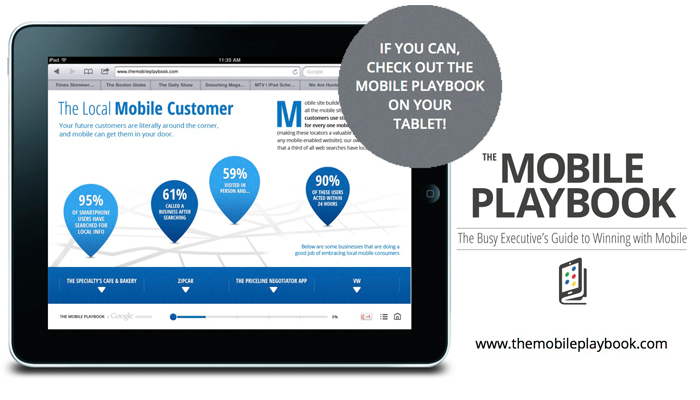Earlier in the week, Google announced some updates to its Mobile Playbook, the company’s mobile marketing vehicle. In their announcement of the update, Google refers to the time earlier this year when they originally released the Mobile Playbook;
At the time, most marketers had already moved beyond the “why mobile?” question, but didn’t know where or how to get started. Now it’s become clear that, when done right, mobile works for marketers. As the industry has evolved, we’re seeing examples of marketers designing compelling mobile creatives, and how savvy advertisers are finding ways to measure the real value that mobile has on their businesses.
A Forbes article by Robert Hof explains further into the reasoning behind Google’s update to their Mobile Playbook, and their launch of the vehicle overall. Robert explains that the main things that marketers worry about with mobile marketing is that they only have such a limited space and screen size to achieve their goals within and that most marketers have no idea how to measure the impact that the mobile marketing efforts will have. Most marketers expect that by measuring the clicks that lead to buys on mobile devices, they are getting the best analysis of their mobile marketing impact possible. However, Robert continues to say that marketers tend to miss the idea of mobile ads leading consumers to actually go out and physically visit stores and businesses, which does happen quite often.
These issues are what have led to marketers’ hesitation in going forward with mobile marketing, in turn leading to problems for some of the big names in mobile marketing, including Facebook, the New York Times, and of course Google. With the customer and user bases of these big names rapidly going mobile, there is quite a need for advertisers and marketers to have a desire for mobile as well.
Now, according to Forbes, Google is trying to create a solution to these problems that marketers are having with putting their trust in mobile. As Robert writes in his article;
First, several examples of mobile campaigns illustrate that the main problem isn’t lack of screen space, but lack of imagination by marketers. ”Mobile is a great canvas for brand-building,” says Jason Spero, Google’s head of global mobile sales and strategy. “It’s going to produce some of the greatest campaigns in digital. But it’s shocking how far behind the [consumer] consensus the broad base of companies are.”
Regarding the problem of measuring impact on mobile platforms, Google has also given several examples of brands and companies that have successfully measured their actual mobile results. Also from Forbes;
Adidas, for instance, with its agency partner iProspect, determined that including the real value of a click on a store locator button, which it had identified from store data, proved that mobile ads were paying off in in-store sales. “Mobile is driving behavior in the real world,” says Spero, and cases such as Adidas’ are starting to prove it.
Google’s Mobile Playbook is taking a step toward letting marketers know that mobile marketing is okay, and that it can and will be very successful, as long as you know how to use it. What better way to learn then from examples?




